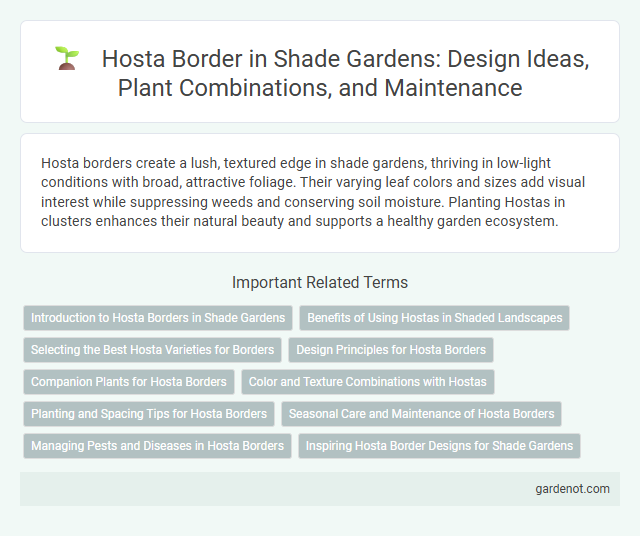Hosta borders create a lush, textured edge in shade gardens, thriving in low-light conditions with broad, attractive foliage. Their varying leaf colors and sizes add visual interest while suppressing weeds and conserving soil moisture. Planting Hostas in clusters enhances their natural beauty and supports a healthy garden ecosystem.
Introduction to Hosta Borders in Shade Gardens
Hosta borders create stunning focal points in shade gardens by offering lush, broad leaves with varying shades of green, blue, and variegated patterns. These perennial plants thrive in low light conditions and require minimal maintenance, making them ideal for shaded garden areas. Incorporating hosta borders enhances texture, depth, and seasonal interest while supporting a diverse ecosystem within the garden.
Benefits of Using Hostas in Shaded Landscapes
Hostas thrive in shaded landscapes by providing lush, textured foliage that enhances garden aesthetics while suppressing weeds through dense leaf cover. Their adaptability to various soil types and low maintenance requirements make them ideal for creating durable, attractive borders in low-light areas. Hostas also improve soil health by retaining moisture and reducing erosion, contributing to a sustainable shade garden ecosystem.
Selecting the Best Hosta Varieties for Borders
Selecting the best Hosta varieties for borders involves prioritizing plants with contrasting foliage colors, textures, and sizes to create visual interest. Popular choices include Hosta 'Sum and Substance' for its large chartreuse leaves, Hosta 'Francee' with its striking white-edged foliage, and Hosta 'Blue Angel' known for its broad, blue-green leaves. Choosing disease-resistant, shade-tolerant varieties with slow to moderate growth ensures a low-maintenance, vibrant shade garden border.
Design Principles for Hosta Borders
Hosta borders create visually appealing shade gardens through strategic layering and varied leaf textures, ensuring depth and contrast. Incorporating different Hosta cultivars by size and color enhances spatial rhythm and maintains balance along pathways or garden edges. Proper spacing and soil preparation optimize growth, resulting in sustainable, lush borders that thrive under dappled shade conditions.
Companion Plants for Hosta Borders
Hosta borders thrive when paired with shade-loving companions such as ferns, astilbes, and heucheras, which complement their lush foliage and enhance garden texture. Companion plants like bleeding hearts and solomon's seal provide seasonal color and vertical interest, enriching the shade garden's visual appeal. Selecting moisture-loving plants with similar soil and light requirements ensures a harmonious and healthy border ecosystem.
Color and Texture Combinations with Hostas
Hosta borders create visual interest through diverse color and texture combinations, pairing blue-green leaves with chartreuse or variegated varieties for striking contrast. The broad, smooth foliage of large-leaf Hostas complements the finely textured, rippled edges of smaller cultivars, enhancing depth and dimension in shade gardens. Combining Hostas with complementary plants like ferns or astilbes accentuates their lush, layered appearance while ensuring vibrant seasonal color and rich foliage texture.
Planting and Spacing Tips for Hosta Borders
Hosta borders thrive with proper planting and spacing, typically set 18 to 24 inches apart to allow mature growth and airflow, reducing the risk of fungal diseases. Selecting a mix of Hosta varieties with varying leaf sizes and colors enhances visual interest and texture in shaded garden areas. Incorporating organic mulch around plants conserves moisture and suppresses weeds, vital for healthy Hosta development in shaded environments.
Seasonal Care and Maintenance of Hosta Borders
Hosta borders require regular seasonal care to maintain lush foliage and vibrant growth, including consistent watering during dry spells and applying mulch to preserve soil moisture and regulate temperature. In early spring, remove dead leaves and apply balanced fertilizer to promote healthy shoots, while cutting back yellowed or damaged leaves in late summer helps prevent disease. As fall approaches, trim back foliage to ground level and apply a layer of organic mulch to protect roots from winter cold.
Managing Pests and Diseases in Hosta Borders
Effective management of pests and diseases in Hosta borders involves regular inspection for slugs, aphids, and fungal infections such as leaf spot. Applying organic slug repellents and maintaining proper spacing enhances air circulation, reducing the risk of mildew and rot. Removing damaged foliage promptly and using insecticidal soaps ensures healthier Hostas and sustained garden aesthetics.
Inspiring Hosta Border Designs for Shade Gardens
Hosta border designs enhance shade gardens by combining diverse leaf textures and varying shades of green, blue, and yellow to create visual interest. Incorporating companion plants like ferns, astilbes, and heucheras adds color contrast and seasonal appeal to the hosta display. Designing layered borders with tall and low-growing hostas maximizes depth and dimension in shaded garden spaces.
Hosta border Infographic

 gardenot.com
gardenot.com